HISTORY
HISTORY
Malpica de Bergantiños is a former 17th century whaling port on the Galician coast. The story indicates that it was Basque sailors who founded this town, which was created as an operations base for the fleet that captured cetaceans in this corner of the Atlantic. Malpica was a privileged vantage point from which to monitor the passage of whales, with the Sisargas Islands as the promontory into the sea.
Documents say that their capture and subsequent marketing was originally in the hands of Cantabrian and Basque sailors, later becoming a task and a business controlled by the clergy, specifically by the bishopric of Mondoñedo, who found strong opposition by the local seamen. Fat, oil, meat and bones were obtained from capturing the whale. Some of these bones came to be used as beams of the roofs on small buildings.
The town of Malpica is documented in the 13th century, in texts that speak of the territory belonging to the Archbishopric of Santiago de Compostela, then going on to be domain of the Conde de Monterrei two centuries later.
Currently, Malpica de Bergantiños is one of the most important artisanal fishing ports in Galicia. It has facilities with a Travel Lift service to facilitate the works to repair vessels, two cranes, a fish market where fish is auctioned and an ice factory, the largest in the Costa da Morte. Fishing is its most noted activity, but there is also tourism and its ancillary services. The main population centre is the municipal capital, which gives its name to the town, but we also have locations like Buño, Seaia or Cerqueda where most of the neighbours of the territory are grouped.
In rural areas we find several livestock facilities, mainly dedicated to the production of milk, as well as producers of top quality horticultural crops.













